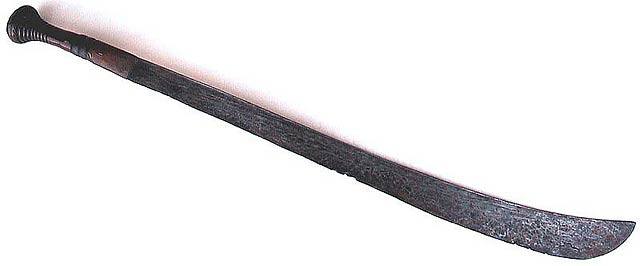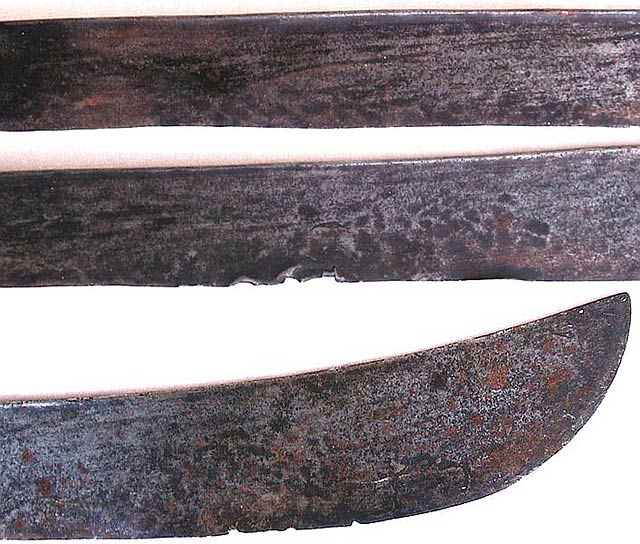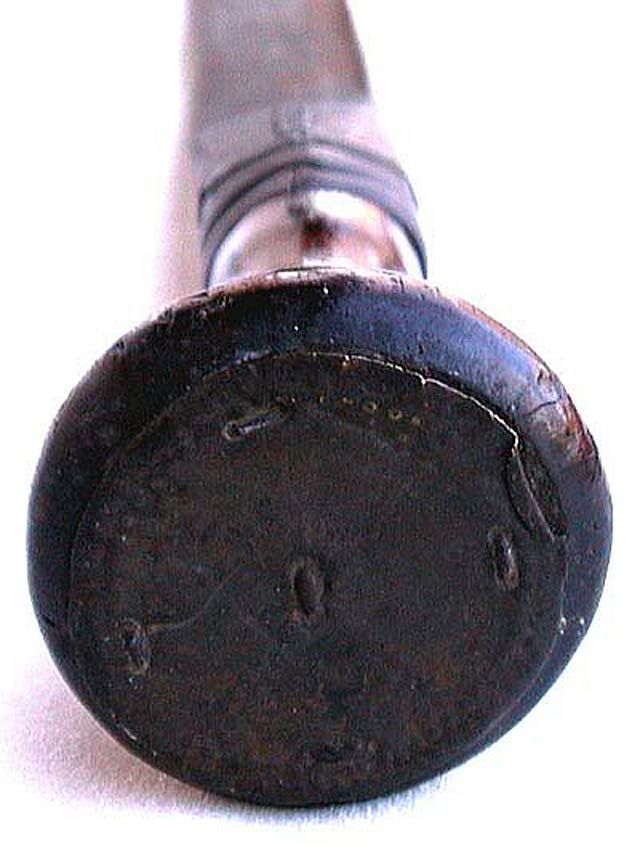
 |
|
|
#1 |
|
Member
Join Date: Mar 2005
Posts: 594
|
Hi All,
Hopefully someone can Id this sword. I'm stumped. The T-rib blade measures 19" (48.26cm) and the hilt is 4.5" (11.43cm). At the hilt the spine measures 9/32" (7.5mm). The blade edge is distinctly rebated from the sides of the blade but the edge thickens up next to the hilt. Near the tip there are three notches on the spine. The regularity of size and spacing indicate deliberate placement by the smith or owner. Save for these notches, the blade is unadorned but shows evidence of folding. The hilt is wood with a brass ferrule and a brass band below the pommel. Both the ferrule and the band have punched decorations that differ on either side of the blade. The carving on the hilt appears to be an imitation of a braided and wound fiber hilt wrapping. The wooden cheeks of the sheath appear to have been held apart by a steam bent piece of rattan? (bamboo?, wood?) that has now broken at the tip. An 8" (20.32cm) wide piece of rawhide forms the sheath throat. The rawhide has been laced together on the back of the sheath with vegetable fiber thread that appears to have been tarred. I suspect the the lower part of the sheath was held together with some sort of wrapping also. Given the blade and hilt shapes plus the notches on the blade, my guess is a south east Asian dha relative but the blade is much lighter in weight than any dha I've seen and the T-rib isnt typical for dha either. The hilt sort of looks like a Thai dha but it's much shorter. So, as I said at the beginning, I'm stumped. Sincerely, RobT |
|
|

|
|
|
#2 |
|
Member
Join Date: Dec 2004
Location: What is still UK
Posts: 5,935
|
Possibly something from the hill tribes around Nagaland to China ???
|
|
|

|
|
|
#3 |
|
Member
Join Date: Dec 2004
Location: Ann Arbor, MI
Posts: 5,503
|
My vote is European blade, African everything else.
|
|
|

|
|
|
#4 |
|
Member
Join Date: Oct 2005
Location: Canada
Posts: 31
|
From the Congo I'd think? European trade machete?
|
|
|

|
|
|
#5 |
|
Member
Join Date: Dec 2004
Location: What is still UK
Posts: 5,935
|
Hmmm. The handle does look African. It could also easily be from the hill tribes of the north east frontier. What if you ignore the coned pommel? Is the bade European? I am not so sure? The scabbard construction has me in two minds. The only bit I see as distinctly African is the leather. I have a wild thought that the blade may have a resemblance to some Nepalese blades. It does not look like an adapted machete to me. It is ground so well to fit the handle? I just do not see a European blade
 , ,
|
|
|

|
|
|
#6 |
|
Member
Join Date: Dec 2004
Location: What is still UK
Posts: 5,935
|
I am not a machete collector but I have never seen a European machete that has not just been a flat blade of a various thickness. Cheap to make flat blades that may often quite flexable. This "T" section is something else in my opinion.
|
|
|

|
|
|
#7 |
|
Member
Join Date: Mar 2005
Posts: 594
|
Hi All,
I'm surprised that the dha folks haven't weighed in on this yet. For my part I agree with Tim's Nagaland/South East Asia contention. I have never seen a T-rib on any European trade blade. Nor have I ever seen a trade machete with the edge rebated (either by the European manufacturer or by local craftspeople). In addition to this, the blade shows evidence of folding. I will admit that the hilt does have a bit of a sub Saharan African feel to it but when I look at it closely there's just something about it that says Asian not African. The blade certainly doesn't look like native sub Saharan African work to me. What the blade profile does look like is a naginata. (It's not of course but the silhouette looks like one.) I can't help thinking that the hilt is the key and tonight I plan a page by page search of Egerton. Sincerely, RobT |
|
|

|
|
|
#8 |
|
Member
Join Date: Dec 2004
Location: Sint-Amandsberg (near Ghent, Belgium)
Posts: 830
|
My guess is that this sword is African. At first, I was thinking of the Baule from Ivory Coast.
But then, I found this pic in the African etnographical collection of the American Museum of Natural history. It resembles your sword, I think. 
|
|
|

|
|
|
#9 |
|
Member
Join Date: Mar 2005
Posts: 594
|
Hi Freddy,
I think you've found a mate to my piece. The museum blade has pretty much the same shape and appears to have a T-rib also. The hilt is also similar and has a brass ferrule plus a brass band below the pommel like mine. What really puts a lock on it is the similarity of decoration on the ferrule. Both pieces must be from the same culture. Presumably the museum's African designation is correct but I really wish they could be more specific. I'll look through Spring and Zirngible tonight to see if I can find out anything further. Thanks a lot for the ID. Sincerely, RobT |
|
|

|
|
|
#10 |
|
Member
Join Date: Dec 2004
Location: What is still UK
Posts: 5,935
|
Good work Freddy, there is always a surprise with African items. I just could not see this "T" section blade with such grinding, beveled edges as typical African metalwork. Nice piece to have.
|
|
|

|
|
|
#11 |
|
Vikingsword Staff
Join Date: Dec 2004
Location: The Aussie Bush
Posts: 4,602
|
Sorry to be coming to this one late. Been traveling for a while.
When I first saw the original subject of this discussion, I was reminded of a sword from the Darjeeling area that I posted some time ago on the old forum. The thread is here: http://www.vikingsword.com/ubb/Forum1/HTML/001602.html What struck me was the T-spine on Rob's mystery sword. The Northern Indian dao I posted also has a prominent T-spine and a blade that widens towards the tip. Also, the "staples" that appear to be used on each hilt to secure parts of the handle. While I'm not questioning Freddy's identification of the African origin of Rob's sword, a number of people had commented on the similarity of Rob's sword to Tibetan forms, and I think that similarity is confirmed by my old "dao" from Darjeeling/Bhutan. Regards, Ian.     |
|
|

|
|
|
#12 |
|
Member
Join Date: Dec 2004
Location: What is still UK
Posts: 5,935
|
Good comments Ian. I think it is possible to suggest that a "Natural History" museum may be wrong in its categorisation. This would not be that unusual, even more specific museums get ethnographic items wrong. Just a thought.
|
|
|

|
|
|
#13 |
|
Member
Join Date: Dec 2004
Location: Italia
Posts: 1,243
|
Tim, the attribution of the museum is right: the picture that Freddy shows is right attribuited to africa. Here is a picture from Westerdijk's book and the swords, that are very similar to the one shows by Freddy, are Hungaan (sud est Congo - Nord Angola). Anyway i think that Ian is right.
|
|
|

|
|
|
#14 |
|
Member
Join Date: Dec 2004
Location: What is still UK
Posts: 5,935
|
I think there is still room for discussion. These drawings are not really showing the same knife or details, yet we have two photos with the same form and details. Also the "T" section blade with similar details post by Ian.
|
|
|

|
|
|
#15 |
|
Member
Join Date: Mar 2005
Posts: 594
|
Hi All,
I don't at all doubt that the sword posted by Freddy is closely related to mine however, I was not and, especially after Ian's post, am not all that sure about the accuracy of the museum's rather vague African designation. "African" covers a lot of territory both spatially and culturally. To me the piece has a strong Asian feel to it. I may be incorrect and the piece may well be African but I will need a more specific cultural affiliation than just "African" to be convinced. While Flavio's post shows swords that are similar to mine I get a feeling of close but not definative. I will hit Spring and Fischer/Zirngibl again tonight. By the way Ian, the decoration on the brass on my hilt is an embossed design They aren't staples. however, since the carving on the hilt appears to imitate a vegetative wrapping, the embossed designs may have been meant to represent staples. Sincerely, RobT |
|
|

|
|
|
#16 |
|
Member
Join Date: Dec 2004
Location: What is still UK
Posts: 5,935
|
I am going to sound so bombastic but I really do think that the Museum are wrong. The weapons and people from the N.E.Frontier are more than just Nagaland and dao's or dha's. To me this is clearly related to both, from that vast area N.India, Nepal, Sikkim, Bhutan, Assam. Areas with pockets of people as isolated and materially poor, in our perceptions as Congo Tribes, especially if you think that this piece may well be 19th century.
|
|
|

|
 |
|
|